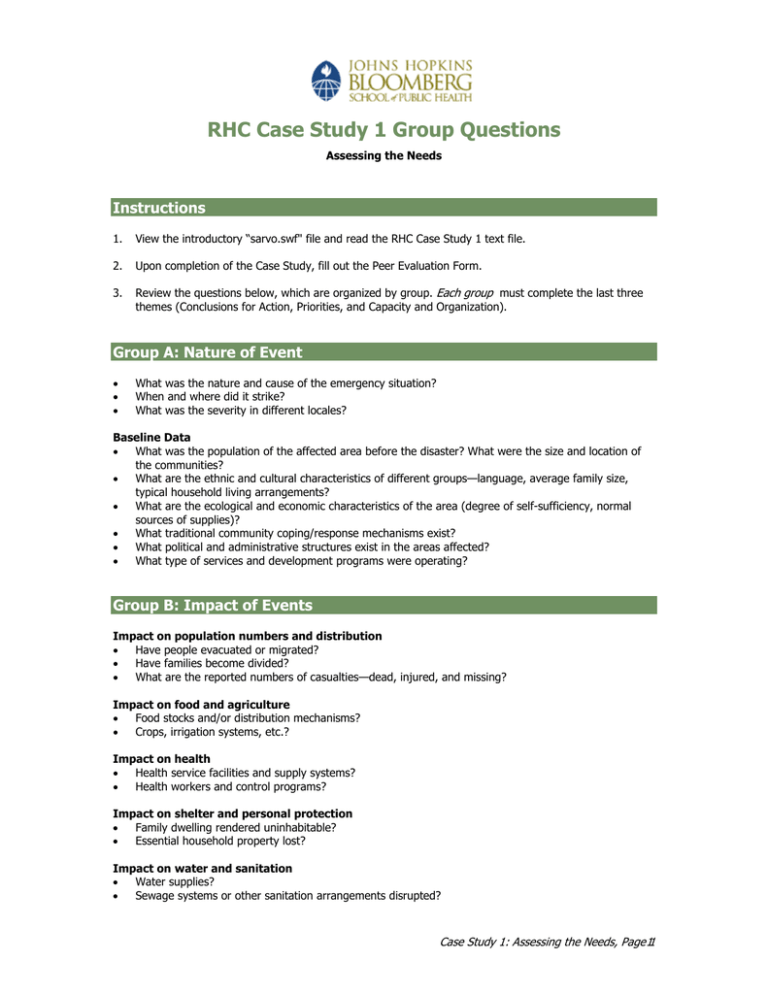
RHC Case Study 1 Group Questions
Assessing the Needs
Instructions
1.
View the introductory “sarvo.swf" file and read the RHC Case Study 1 text file.
2.
Upon completion of the Case Study, fill out the Peer Evaluation Form.
3.
Review the questions below, which are organized by group. Each group must complete the last three
themes (Conclusions for Action, Priorities, and Capacity and Organization).
Group A: Nature of Event
•
•
•
What was the nature and cause of the emergency situation?
When and where did it strike?
What was the severity in different locales?
Baseline Data
•
What was the population of the affected area before the disaster? What were the size and location of
the communities?
•
What are the ethnic and cultural characteristics of different groups—language, average family size,
typical household living arrangements?
•
What are the ecological and economic characteristics of the area (degree of self-sufficiency, normal
sources of supplies)?
•
What traditional community coping/response mechanisms exist?
•
What political and administrative structures exist in the areas affected?
•
What type of services and development programs were operating?
Group B: Impact of Events
Impact on population numbers and distribution
•
Have people evacuated or migrated?
•
Have families become divided?
•
What are the reported numbers of casualties—dead, injured, and missing?
Impact on food and agriculture
•
Food stocks and/or distribution mechanisms?
•
Crops, irrigation systems, etc.?
Impact on health
•
Health service facilities and supply systems?
•
Health workers and control programs?
Impact on shelter and personal protection
•
Family dwelling rendered uninhabitable?
•
Essential household property lost?
Impact on water and sanitation
•
Water supplies?
•
Sewage systems or other sanitation arrangements disrupted?
Case Study 1: Assessing the Needs, Page 11
•
Childcare and other social services, i.e., schools?
Impact on communications and logistics
•
Telecommunications within the area and to outside locations?
•
Transport routes and capacity?
Impact on economic activity—employment and income-generating opportunities?
Group C
Present Situation
•
What are the weather conditions at present?
Community Response
•
What are people/survivors already doing to help themselves?
•
Are traditional coping mechanisms operating?
•
If not, what are the reasons?
•
Have any self-help groups/arrangements been established?
Food, Nutrition, and Income
•
Are any particular groups without adequate food? If so, is it due to lack of supplies or lack of
purchasing power or something else?
•
Have any self-help groups/arrangements been made? By whom?
Health
•
Are there any immediate health problems?
•
Are there adequate medical personnel? Do they have facilities and supplies to live and work?
Shelter and Personal Protection
•
Is survival threatened by lack of shelter, clothing, etc.?
Water and Sanitation
•
Are at least minimum quantities of safe water available to all communities?
•
Is lack of adequate sanitation posing immediate health risks?
Child Care
•
Are there children in need of special care—unaccompanied, traumatized, disabled?
•
Are traditional care arrangements and social services functioning?
Logistics
Can supplies be brought into the area?
•
What are the specific constraints?
•
Administration
•
Are there any problems of law and order?
•
Is the local administration functioning effectively?
Assistance
•
What is the government already doing/planning? Has there been an official request for aid?
•
What other organizations are present? What are they doing/planning?
Group D: Probable Evolution
•
What weather conditions are forecast for the immediate future? What are the implications for survival,
communication, and logistics? You can address temperature, etc.
Case Study 1: Assessing the Needs, Page 2
•
•
•
•
•
Are any secondary disasters or incidents likely to ensue?
What health risks arise from changes in the environment in which people are living?
How are the people expected to respond—what further actions will they be taking for themselves?
Are disruptions to market mechanisms, supply systems, and employment opportunities likely to have
short or long term effects?
What policies and actions are the government and others expected to pursue?
All Groups: Conclusions for Action
(The themes below should be addressed by each group)
The following immediate actions (specify actions, target beneficiaries, and locations) are required to meet
immediate needs:
•
•
•
•
•
•
•
Access to food supplies
Household functioning
Health Care
Shelter and personal protection
Water supplies
Sanitation
Special care for children
Priorities
•
The overall priorities of the various communities are _____?
•
The most severely affected areas and population groups are _____?
•
Special considerations arising from the nature of the area/location are ____?
•
More detailed surveys and investigations should be undertaken to determine needs and identify
appropriate response in respect of ____?
Capacity and Organization
•
Local capacity to handle the required relief and rehabilitation operations should be strengthened by
____?
•
Other in-country capacities that should be mobilized include ____?
•
To ensure effective coordination and control at local and national levels, action should be taken to
_____?
Copyright 2005, Gilbert Burnham and The Johns Hopkins University. All rights reserved. Use of these materials permitted
only in accordance with license rights granted. Materials provided “AS IS”; no representations or warranties provided.
User assumes all responsibility for use, and all liability related thereto, and must independently review all materials for
accuracy and efficacy. May contain materials owned by others. User is responsible for obtaining permissions for use from
third parties as needed.
Case Study 1: Assessing the Needs, Page 3



